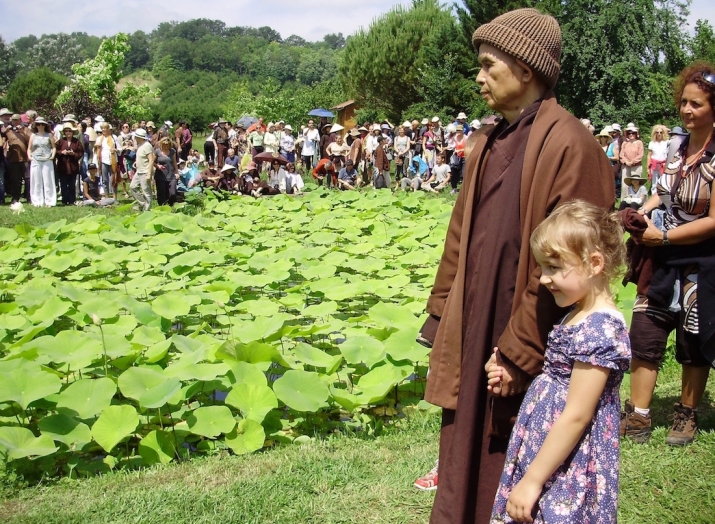FEATURES|THEMES|Commentary
Buddhistdoor View: Balancing “Family” Love with Love for All Beings
 Thich Nhat Hanh leads families on walking meditation in Plum Village, France. From anotherdharmadoor.wordpress.com
Thich Nhat Hanh leads families on walking meditation in Plum Village, France. From anotherdharmadoor.wordpress.comThe Buddha’s approach to human relationships has not always been universally admired. Perhaps his most socially contentious deed was his abandonment of his family and kingdom to search for a way to liberate all beings from suffering. Hardline Confucians, such as Chŏng Tojŏn (1342–98), the first prime minister of Joseon Korea (1392–1897), rounded on Buddhists for their apparently upside-down priorities of desiring to feed their own bodies to “fierce animals” and “insignificant bugs” while seeking to “sever the relationship” between fathers and sons. (Muller 2015, 66) Other writers did not like the Buddha’s ostensible desertion of his wife Yasodhara, who by some accounts endured significant emotional distress for many years as a result. One translator of Sanskrit poet Ashvaghosha’s (c.80–c.150 CE) work Handsome Nanda—in which the Buddha convinces Prince Nanda to give up his beloved wife for the monastic life—observed that the poem should come with a warning that it could seriously damage one’s love life!
Whether expressed as concern about Buddhism’s potential “subversion” of the family as a social institution or a wry observation about Buddhism’s deconstructive message, these critiques do not reflect the reality on the ground. Historically, it has never been difficult for Buddhism to diffuse its monastic institutions into diverse societies, all of which politically and socially uphold traditional family structures. The landholding families of modern Japan’s great Buddhist sects actively marry and produce heirs. Teachers representing contemporary Chinese Buddhism, such as Master Hsing Yun, place great emphasis on family harmony and cooperation in their writings and Dharma talks. Other schools, such as Vajrayana Buddhism’s Nyingma tradition or lay Japanese and Western groups, do away with monasticism altogether, embracing lay leaders who are married parents.
The supposed dichotomy of prioritizing loving “family” over loving “others” also does not seem to be helpful or even relevant for a world in which it is common for people to treat biologically unrelated individuals (aside from spouses or lovers) as “family”—the student who behaves like a son to a teacher long after graduation, buddies who have grown up together effectively as siblings, or the kindly old neighbor who becomes a surrogate grandparent to a lonely child. Instead, a common issue stemming from such close bonds of “family” is that they commonly lead to attachment. Whether a blood relation or not, we feel intense attachment to those we care about, and that affection, even when manifesting in positive acts and reciprocated, can be unintentionally restrictive or harmful.
Therefore, if Buddhism has no real problem with the concept of family, the question is probably better framed as one of cultivating nonattachment and letting go of possessiveness. This means practicing equanimity (upeksha)—one of the Four Divine Abodes or brahmavihara—which is concerned with the ability to see all beings as equal and not discriminating between ourselves, those close to us, or strangers and enemies.
 Prince Siddhartha, the Buddha-to-be, leaves his wife and son to pursue the life of a mendicant. From dhammatalks.net
Prince Siddhartha, the Buddha-to-be, leaves his wife and son to pursue the life of a mendicant. From dhammatalks.netIn some contemporary literature, equanimity is framed as a meditative antidote to bias or aversion against those who we dislike or have hurt us. Yet what of the attachment and bias that disposes us to a deep clinging to our loved ones? Most lay Buddhists have family priorities in the conventional world: to commit love, time, and resources to their spouse, children, or other relations. Even monks and nuns that become “sons and daughters of the Buddha” (in the Chinese tradition, quite literally by taking the surname “Shih,” the Chinese character for the Buddha’s clan name “Shakya”) inevitably feel a kinship with their new sangha family.
The challenge of Buddhism is to apply equanimity as an antidote to attachment. Zen Master Thich Nhat Hanh writes in Teachings on Love: “Without upeksha, your love may become possessive. A summer breeze can be very refreshing; but if we try to put it in a tin can so we can have it entirely for ourselves, the breeze will die. . . . Yet many people do just that. They rob their loved one of his liberty, until he can no longer be himself. They live to satisfy themselves and use their loved one to help them fulfill that. That is not loving; it is destroying.” (Thich Nhat Hanh 2002, 9–10)
There is one more challenge that, when fully grasped, is more difficult than those already mentioned: to feel, in one’s very bones, that all beings have at one point been our mothers, and by logical extension, every family relation conceivable. Meditating on all beings as our mothers in past lives is commonly prescribed as a pedagogical exercise to cultivate loving-kindness (metta). To truly accept such a worldview as a metaphysical reality seems to mean that the next ethical step should be to try to relinquish clinging to those closest to us. The idea that every being in the universe has been a family member since beginningless time has ethical implications that are as inspiring and transformative as they are daunting for anyone living in the conventional world of secular duties and attachments.
References
Korea’s Great Buddhist-Confucian Debate: The Treatises of Chŏng Tojŏn (Sambong) and Hamhŏ Tŭkt’ong (Kihwa), translated and introduced by A. Charles Muller. 2015. Honolulu: University of Hawai‘i Press.
Thich Nhat Hanh. 2002. Teachings on Love. 2nd edition. Berkeley, California: Parallax Press.
See more
Insights: On “Handsome Nanda” (Clay Sanskrit Library)
An explanation of the four immeasurables (Bhikshuni Thubten Chodron)














